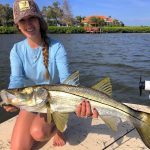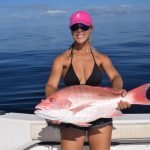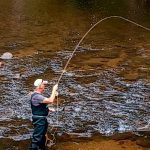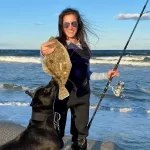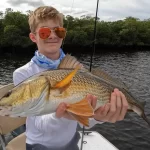Freshwater Fishing Tackle and Lures, a Comprehensive Guide
This article on freshwater fishing tackle and lures will help anglers new to the sport choose the tackle and lures that will need to get started fishing. The selection of fishing equipment is extensive and in some cases, overwhelming. It can be quite confusing. In this article Capt Jim will break it down and give recommendations. This will help simplify the process for anglers new to the sport. There is no one set of tackle and lures that will cover every fishing situation.

Capt Jim Klopfer is a fishing guide in Inverness, Florida. He grew up in Maryland, fishing both freshwater and saltwater. Capt Jim fishes the lakes and rivers of Florida often. He also has a home in Franklin, NC. He fishes there for trout and smallmouth bass. In this article Capt Jim will not list every lure option, this will just overwhelm anglers. Instead, he will give you his personal favorites.
Freshwater fishing rods and reels
The primary piece of equipment that an angler will need is the fishing rod and reel. The rods are fairly similar. The reel seat and guides are a bit different. Rods come in various “actions”. Capt Jim likes a “fast” action. This means that the rod is stout at the butt (reel) end but limber at the tip. Most outfits are well matched from the manufacturer.

Fishing rods have recommendations for line and lure size right on the blank. This really aids anglers in determining the best rod and reel combination to use for their application. The rod length, weight, action, and recommended line size are usually listed on the blank an the bottom, near the handle.
There are three choices when it comes to reels. These are spin cast (closed faced), spinning (open faced), and conventional (baitcasting). Each has advantages and disadvantages.
Spin cast rods and reels
Many anglers caught their first fish on a spin cast outfit. These have several names including “push button” and “closed faced”. The line is released by pushing a button on the the back then releasing it to let the line out. A cowl with a hole in it covers the spool. These reels are inexpensive and fairly easy to use. They are not a bad choice for children and novice anglers.

Spin cast reels do have their limitations. They do not hold much line. Also, the retrieve ratios are usually low, meaning the line comes back in slowly. Finally, the drags are fair at best. That said, these outfits do have a loyal following and plenty of big fish have been landed by anglers using them. Spin Cast outfits are available in a variety of sizes. Ultra light rigs are best for panfish while the largest versions can handle a big catfish. Below are a few recommendations for anglers to choose from.
Click link to shop Amazon for spincast combos
“Fishing Lido Key is a participant in the Amazon Associates Program, an affiliate advertising program designed to provide a means for sites to earn advertising fees by advertising and linking to Amazon. As an Amazon Associate I earn from qualifying purchases.”

Freshwater fishing with spinning outfits
For most anglers freshwater fishing, spinning tackle is the best choice. Some anglers refer to them as ‘open faced” reels. This is due to the fact that the spool is open and easily seen. A bail covers the spool. It is flipped to allow the line to be cast. Anglers put the line under their index finger and let it slide off when casting.

Spinning reels are affordable, versatile, and fairly easy to use. They come in many different sizes. Reels are sized by number, usually using four digits. A 1000 reel is small while a 6000 reel will catch a big fish. Most spinning reels can be reeled from either side. The handles swap over in a matter of seconds. This is an advantage that neither spin cast or conventional reels offer.
Anglers have a wide range of choices when it comes to a spinning outfit. A quality unit can be purchased under $100. A serviceable rig can be purchased for much less that that. Below are a few option to choose from for anglers that would like to shop. “10” sized reels are the same as “1000”, 30 sized reels are the same as “3000”.
Click this link to shop Amazon for KastKing spinning combos
A 1000-2000 series reel on a matching rod is a good all round choice for anglers fishing for smaller fish such as panfish, trout, small bass, and small catfish in smaller waters. Anglers will often be casting small lures and baits. Light tackle is required for this. 4lb or 6lb line should be used with these outfits.
A 3000-4000 series reel is better suited for anglers tossing heavier lures and baits for larger fish. These are still light enough to fish for smaller fish. However, the battle will not be as enjoyable. Still, it is a good choice for anglers who will be fishing in a variety of waters for both small and medium sized fish. Bass, walleye, larger trout, carp, and catfish are examples of this. Spools should be filled with 8 lb to 12 lb line.
5000-6000 series reels and larger are for anglers seeking big fish. This includes casting heavy baits for big catfish and carp. Big striped bass, northern pike and musky will also require this heavier tackle. For the most part, this type of tackle is too heavy for average freshwater fishing. Lines testing 17lb to 20lb work best.
Conventional, or bait casting rods and reels
The third option for anglers is a conventional or ‘baitcasting” outfit. These are most often used by experienced anglers. They cost more money and are difficult to master. However, in skilled hands, they are awesome! The line comes on the spool. When cast, anglers “thumb” the spool to prevent an over run (tangled line).

Click this link to shop Amazon for Lew’s baitcasting outfits
Conventional outfits are the best choice for anglers who like to troll. Reels can even be purchased with “line counters” to let anglers know how far back the lure is. These are also good for anglers who like to bottom fish for big catfish. Below are a few recommendations.
Click this link to shop Amazon for a conventional freshwater rod and reel
Freshwater fishing line choices
Fishing line comes in several variations as well. Like everything else, there are advantages and disadvantages to them. The choices are monofilament, flourocarbon, and braid.

Monofilament is the best choice for most novice anglers. It is inexpensive and knots are easy to tie. Flourocarbon is great, but quite expensive. Braided line is expensive, but lasts a long time. It has no stretch, improving the sensitivity. Knots are more difficult to tie and anglers often use a leader with braid. Braided line will last a long time and will not twist.
Click these links to shop Amazon for braided and monofilament fishing line
Fish hooks, sinkers, and floats
Anglers freshwater fishing with live or cut bait will need hooks, sinkers, and sometimes leaders and swivels. This is just basic gear for basic fishing.
Freshwater fishing hooks
Hooks come in a variety of sizes and styles. It gets a tad confusing in the larger sizes. The larger the number, the smaller the hook. A #2 hook is much larger than a #12 hook. However, in the larger hooks, they use the “ought” sizing. A 1/0 hook is larger than a #2 hook. A 5/0 hook is larger than a 1/0 hook. Confused?

Just to keep it simple, anglers should get “baitholder” style hooks in various sizes. These have little barbs on the shank that help hold the bait. #10-#8 is good for panfish. #2 would be good for crappie and smaller bass. #1/0 is a good size for catfish and larger game fish. Anglers should match the hook to the size of the bait, not the size of the fish being sought. This will result in a more natural presentation.
Fishing sinkers
Fishing sinkers also come in many sizes and shapes. Basically, they all do the same thing; get the bait down in the water column. Small split shot can be pinched on the line and are good for fishing in shallow water. Egg sinkers slide on the line. Bank sinkers are used for bottom fishing. Anglers can read all about light tackle bottom fishing in this article on light tackle bottom fishing.
Fishing floats
Floats, or bobbers, are used to suspend the bait at a desired depth. They also serve to provide casting weight as well as giving a visual reference to a bite. Bobbers come in various sizes and styles. A handful of round red and white bobbers in several sizes will cover most situations.
Click this link to shop Amazon for fishing floats
Freshwater fishing lures
It surprises many anglers new to the sport that artificial lures can out-fish live bait. How can a fake or plastic bait be more appealing that something real? The answer is that fish bite for several reasons. These include angler, hunger, excitement, competition, and defense.

Lures have two big advantages. Anglers can cover a lot more water with artificial lures than they can with bait. Also, lures can trigger strikes from inactive fish. Many lures are designed to vibrate or flash to elicit these reflex strikes.
Lures come in several basic design types. These include soft plastic baits, jigs, hard body baits or “plugs”, spinners, spinnerbaits, and spoons. Capt Jim will cover each of these along with his preferred baits.
Soft plastic freshwater fishing lures
Soft plastic baits are incredibly effective fishing lures. Back in the day “rubber worms” fooled a lot of bass. Since their introduction in the 1960’s, soft plastic baits have come a long way. Bait mimic everything from worms, lizards, frogs, crayfish, minnows, and more. Some resemble nothing that lives but still catch fish! They are fished on a hook or some type of jig head. Soft plastic lures, no matter the brand or type, belong in every freshwater tackle box. They are extremely versatile, cost effective, and most important, they will catch just about every freshwater species.

Capt Jim really likes the GULP line of baits. He uses the saltwater versions extensively on his fishing charters. The freshwater baits work great as well. They come in a wide variety of sizes and styles. GULP baits are heavily scented and really combine artificial lures with live bait.
Click these links to shop Amazon for Gulp Alive minnow and Jerk Shad baits

Mister Twister makes a terrific line of soft plastic baits. They basically invented the curly tail grub. These range from tiny baits for panfish to larger ones for big bass. Capt Jim prefers the 2″ version in chartreuse for a variety of game fish. He will use the 1″ Teeny grub for panfish and larger 3″-4″ baits for bass and stripers.

Click this link to shop Amazon for Mister Twister lures

The Yamamoto Senko is a fantastic soft plastic bait. It is Capt Jim’s favorite plastic worm, by far. The Senko has incredible action and does not require a lot of action by the anglers. It can be rigged a variety of ways. Green pumpkin flake is a great all round color. The 4″ worm is a great all round size, but the 5″ bait is best for largemouth bass.
Click here to shop Amazon for Senko baits
Rigging soft plastic baits
Soft plastic baits can be rigged several ways. Plastic worms are rigged to be weedless on special hooks. This is called a “Texas rig”. Swimbait hooks are another special design that work well on larger baits.

Click this link to shop Amazon for swimbait and worm hooks
Soft plastic lures can also be rigged on a jig head. This is the method that Capt Jim prefers. It works especially well on smaller panfish baits. However, larger plastic baits are extremely effective on jig heads, particularly for walleye and smallmouth bass.
Freshwater fishing jigs
Jigs are similar to a soft plastic bait rigged on a jig head. The difference is that the jig is a complete unit. It comes with a jig head along with some type of dressing over the hook. This can be a natural material such as buck tail or marabou. These look very natural in the water. Synthetic hair is popular as well. Some come with rubber legs that undulate enticingly in the water.

Capt Jim’s favorite jig for freshwater fishing is the Blakemore Roadrunner. It comes in sizes for every fishing application and will catch every species. The lure can be purchased with a marabout tail or plain so that anglers can add a soft plastic tail. It also has a spinner blade which adds flash and vibration. It is very effective on just about every species, but particularly so on crappie. Panfish will take it as well. Bright colors such as chartreuse, pink, and white work well.
Click this link to shop Amazon for Road Runner lures
Freshwater fishing plugs
Plugs are hard baits that used to be wood and are now almost all plastic. For the most part, they mimic bait fish. However, some are crayfish and other imitations. Some plugs are worked on the surface. These are called “topwater” plugs. Others have a lip which causes them to dive down into the water. Plugs can be cast or trolled.

Plugs are easy to cast. Most have a built in action that makes them easy to use. On the negative side, plugs are expensive. They also have treble hooks which are more dangerous when casting or unhooking fish. However, they are very productive and a lot of fun to fish!

The Heddon Tiny Torpedo is Capt Jim’s favorite topwater plug. It has been around a long time and still catches fish. The size is perfect for catching fish of all sizes.

The Rapala X-Rap Extreme Action Slashbait is Capt Jim’s favorite sub-surface plug. This type of bait is knows as a “jerk bait” due to the manner in which it is worked. The lure is sharply jerked then paused. This pause usually draws the strike. Colors vary depending on the water fished. White is a great all round color. #8 is a good size for most species.


The Bill Lewis Rattletrap is a lipless crankbait. It is easy to use. The angler simply casts it out and reels it back in with a steady pace. This lure has a ton of built in action that provokes strikes from inactive fish. Chrome with a blue back is a top color pattern
Click these links to shop Amazon for Tiny Torpedo Rapala X-Rap and Rat-L-Trap lures
SPINNERS

Spinners are simple yet effective freshwater fishing lures. They consist of a shaft with a blade that rotates, emitting flash and vibration. The hook is on the tail and is often dressed with hair. Spinners are easy to use and are extremely effective, particularly in streams and rivers. They can also be trolled.

The Wordens Roostertail is Capt Jim’s favorite spinner. It is also by far his favorite river fishing lure. The Roostertail is extremely effective on all trout species, particularly in streams. It also produces trout and panfish in lakes and ponds. The larger versions will catch pike, musky, and bass. Color patterns are endless. Capt Jim likes bright colors with a gold blade. They are available in single hook versions for trout fishing where treble hooks are not allowed.
Click this link to shop Amazon for Rooster tail spinners
Spinnerbaits

Spinnerbaits are odd looking lures that really do not resemble anything in nature. However, they do combine two great lures; spinners and jigs. They have a wire frame that resembles a safety pin. A blade or blades run at the top. A jig with a skirt or grub is at the bottom.

These are terrific artificial lures for novice anglers! The cast well and are very easy to use. They also have a single hook, which makes releasing fish easy. The design also makes them very weedless. There are a lot of great spinnerbaits out there. However, Capt Jim loves the Johnson Beetlespin. The small versions are extremely productive on panfish. Larger models catch bass and other species. Black is his favorite color.

Click here to shop Amazon for Beetle spin lures
Freshwater spoons
Spoons are a simple lure that have been around a very long time. Basically they are a bent piece of metal with a hook at the rear. Properly designed, they wobble and flash enticingly, putting out flash and vibration. Spoons cast a long way and are easy for novice anglers to use. Anglers should use a swivel with a spoon to reduce line twist. Spoons are also very effective ice fishing lures.

Spoons can not only be cast, but are extremely effective when trolled. Walleye, trout, and salmon anglers have been catching fish with them for decades. The spoon that Capt Jim likes best is the Acme Kastmaster. Small models are great for river fishing for trout and smallmouth bass. Larger spoons work well for other game fish. Gold is his first choice, silver is second.
Click this link to shop Amazon for Kastmaster spoons

An article on spoons would not be complete without recognizing the Eppinger Daredevil. This is THE lure for northern pike. It is also effective on musky, bass, walleye, and other species. It comes in several color patterns, with the red and white and “five of diamonds” patterns being the best.
Click this link to shop Amazon for Daredevil spoons
Chatterbaits

Chatterbaits are a fairly recent addition to the freshwater fishing scene. In some areas, they are replacing spinnerbaits as they are similar, but more compact. A chatterbait is also known as a vibrating jig. It combines a jig and a spinner or spoon in one unit. They cast well and are particularly effective when fishing in grass.
Miscellaneous fishing gear
There are a few other items that anglers will need to get started fishing in freshwater. These include a pair of pliers, landing net, good pair of sunglasses, bait bucket (if fishing with minnows), fillet knife (if keeping fish), and waders, if needed. Like any hobby, equipment is needed to enjoy the sport.
Freshwater fishing techniques
Capt. Jim Klopfer is a fishing guide in Sarasota Florida. He has been doing this since 1991. Capt. Jim is a well-rounded angler who has fished all over the country. He has broken down fishing into these best 5 fishing techniques in an attempt to simplify and help anglers better understand how to catch more fish.
There are many different baits and lures which can be used. However, they all still fall into the techniques being used as opposed to what’s actually tied onto the end of the line. That is the approach that will be taken in this article.
Best fishing techniques; casting
Casting is the most popular angling technique. This is simply the act of tying on a lure or bait and using the rod and reel to launch the lure or bait a distance away. This can be done from a boat or from shore as well as bridges and piers. Casting has the advantage in that anglers can position their offerings exactly where desired and easily reel it back in and repeat the process.
Anglers can cast both natural baits and artificial lures successfully. Artificial lures are cast out and retrieved back in. Live and cut baits are usually allowed to set relatively still and use scent or action to attract fish to the hook.
Casting with lures
Casting and retrieving artificial lures has one huge advantage over anglers fishing with bait; they can cover a lot more water in search of fish. Lures are available in many different variations which allow them to cover the entire water column, from the surface down to the bottom.
Lures are usually cast out towards some type of structure that an angler think may hold fish. This includes man-made structure such as docks and natural structure including vegetation, points, drop-offs, and ledges. Fish will strike lures for a variety of reasons other than hunger. These include anger, excitement, competition, and defense.
Bait fishing
Many anglers cast out a live or cut bait in search of fish. This was probably the way man first began to fish, by attaching some live bait to a hook and throwing it into the water. As simple as this is, it still continues to catch fish to this day. It is perhaps the most dependable fishing technique out there and works well for novice anglers.
Live bait can be presented in a variety of manners. Anglers can fish it under a float to suspend the bait at the desired level as well is using the float to indicate a strike. This is often done when casting to shoreline vegetation in fairly shallow water. Bait can also be allowed to swim on it so naturally with nothing but a hook. This is called free lining a bait.
Many anglers cast a bait out with the use of a sinker or weight. The weight not only provides the angler the ability to cast the bait out quite a distance, it also takes it down to the bottom were many fish feed. This is especially true with any type of cut bait or commercially prepared baits.
Best fishing techniques; trolling
Trolling is a very effective fishing technique. It basically involves slowly moving the boat forward while pulling multiple lines behind. Technically, trolling can be accomplished by anglers walking a shoreline or seawall, but the vast majority of trolling is done with a boat. The primary advantage is to be able to offer multiple baits at various depths. This aids greatly in finding fish when they are scattered out over a large area or suspended in open water.
There are several methods that anglers can use when trolling to get the lures or baits down to the desired depth. The easiest trolling method is to use diving plugs. These are hard bodied lures that resemble bait fish. They have a large lip on the front which determines the depth at which the plug will run. This makes it fairly easy for an angler to work the depth that is desired. These lures have excellent built in action as well.
Sinkers are another fairly simple method used by anglers when trolling to control the depth at which there baits will run. Anglers have the choice of using an in-line sinker or a sinker on a drop her off of a three-way swivel. Both work fine, though the in-line sinker is used in open water and the three-way swivel is used when snags are more of a problem.
Trolling techniques
Downriggers are expensive and a bit more complicated, but are an excellent tool to use to control depth when trolling. It looks like a small fishing rod with an arm and a real. It uses a wire cable and a heavy ball to get down to the desired depth. There is a clip on the ball that releases when a fish strikes. This technique was developed by anglers in the Great Lakes to catch salmon and trout.
Planers are the final method used by anglers when trolling to control depth. These are clever devices that dig down into the water when pulled then trip or release when a fish strikes. They are more common in saltwater fishing that in freshwater fishing and allow anglers to troll quite fast, up to 7 miles an hour or so.
While lures are mostly used, anglers can use live bait with this fishing technique as well. This is a bit of a specialty application used in salt water and in freshwater for striped bass. Anglers control live bait using sinkers or behind a downrigger.
Best fishing techniques; bottom fishing
Bottom fishing is an extremely effective fishing technique. The reality is that more fish relate to bottom structure then do those that swim or suspend in the middle of the water column. Structure on the bottom provides cover and safety as well as forage. Therefore, presenting a lure or live bait on the bottom will be productive and many fishing situations.
Most bottom fishing is done by anglers using live or cut bait. Since artificial lures are usually on the move, they are not quite as effective when bottom fishing. Conversely, both live bait and cut bait our perfect for bottom fishing. Anglers have several different rigs to choose from, but all are similar in that they use a weight or sinker and a hook or hooks to present a live bait or chunk of cut bait on the bottom.
Most bottom fishing is done on some type of structure. In freshwater fishing, this can include fallen timber, submerged rock piles, sloping points, and channel edges as well as man-made structures such as bridges. Anglers saltwater fishing will bottom fish over natural reefs and ledges, wrecks, artificial reefs, and more.
While most bottom fishing is done with live or cut bait, anglers can certainly present artificial lures on the bottom as well. This is most often done with slow-moving soft plastic baits such as plastic worms and to baits. Jigs can also be used. While not strictly considered bottom fishing, these lures are slowly worked or crawled across the bottom in search of fish.
Best fishing techniques; drift fishing
Drift fishing is a very efficient angling technique. It is similar to trolling in that anglers can cover a good amount of area in search of fish while keeping the baits directly in the strike zone. The difference is that instead of using a boat to move the lures or baits, natural elements such as current and wind are used to move the boat over a productive area.
The two primary components involved in drift fishing are wind and current. In freshwater fishing lakes, when will be the determining factor in most cases, though there are situations where current can be strong. In saltwater fishing, current created by tidal flow are much stronger. Wind is certainly a factor as well.
The basic technique for drift fishing is fairly simple. An angler determines the area that he or she wants to fish, then positions the boat upwind or up tide of the area to be fished. The boat then slowly drifts across that area while lures are presented at the desired depth. Baits are often presented right on the bottom in this situation. Live and cut baits are very effective. Anglers can certainly present live baits or lures anywhere in the water column while drift fishing.
The two top artificial lures used when drift fishing are bucktail jigs and jigging spoons. Both are very effective lures that work well and a drift fishing situation. They put out great action when presented vertically and can be used to work the entire water column. Anglers can even combine the two and use a jig or spoon with a live bait or piece of cut bait attached.
Fly fishing
Fly fishing is the most difficult fishing technique to master. There are a lot of factors involved. Many books have been written on the subject but we will briefly cover fly fishing here.
The primary difference between fly fishing and other types of fishing are that with fly fishing the the line is cast out and the fly follows behind. In all other types of fishing, the lure or bait provides the weight. However, fishing flies weight next to nothing it would be impossible to cast using their weight alone.
Flies can be used to work the entire water column from the surface down to the bottom. Anglers have a wide variety of choices and lines and flies that allow them to do so. Floating lines will stay on the surface while anglers can purchase sinking lines that sink at varying rates to match the current fishing conditions.
The fly itself can mimic either a fly or just about any other type of forage that fish feed on. Many anglers associate fly fishing with trout fishing and streams, but anglers fly fish for just about every species in both fresh and saltwater. Any fish that will take and artificial lure can be caught on a fly.
In conclusion, this article on freshwater fishing tackle and lures will help beginner anglers understand what gear they need to get started!

